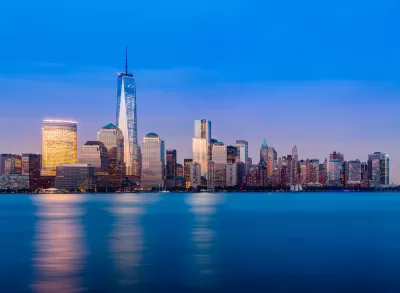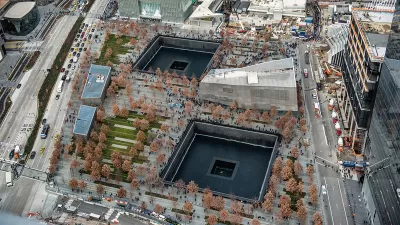Despite predictions that the events of September 11, 2001 would be the end of skyscrapers, U.S. cities are building more tall buildings than ever.

In the days following 9/11, "[a] Chicago developer told Chicago Tribune architecture critic Blair Kamin that American cities shouldn’t allow new skyscrapers that could 'be viewed as a magnet for future terrorism,'" and Americans wondered whether they would ever feel safe in tall towers again. Yet since 2001, "a dozen towers have gone up in Chicago that top 700 feet," writes John King, and other cities are seeing similar rates of construction.
According to Carol Willis, director and curator of the Skyscraper Museum in New York, "there are strong forces that cause towers to grow when there are good economic conditions. They’re weeds." As the rebuilt towers went up in place of the fallen World Trade Center, "[p]eople were reminded that tall buildings can express the spirit and potential of large cities." Today, the area surrounding Ground Zero "is ringed with towers that include the 1,776-foot One World Trade Center, the nation’s tallest building."
"In terms of a city’s daily life, the best towers are the ones that give something to the public. They’re approachable, with shops and cafes and nooks that are open to people who never enter the high-rise lobby." In San Francisco, says King, "when you walk along Folsom Street, or cut through landscaped mid-block plazas that didn’t exist before, the skyline show is secondary to the pedestrian environment slowly starting to emerge." According to Brian Lee, a consulting partner at Skidmore Owings & Merrill in Chicago, "[b]uildings should be meaningful for your time. If it’s just arbitrary shaping, that’s super-disappointing."
FULL STORY: 9/11 was supposed to end the age of skyscrapers. Instead, there are more now than ever

Planetizen Federal Action Tracker
A weekly monitor of how Trump’s orders and actions are impacting planners and planning in America.

Map: Where Senate Republicans Want to Sell Your Public Lands
For public land advocates, the Senate Republicans’ proposal to sell millions of acres of public land in the West is “the biggest fight of their careers.”

Restaurant Patios Were a Pandemic Win — Why Were They so Hard to Keep?
Social distancing requirements and changes in travel patterns prompted cities to pilot new uses for street and sidewalk space. Then it got complicated.

California Homeless Arrests, Citations Spike After Ruling
An investigation reveals that anti-homeless actions increased up to 500% after Grants Pass v. Johnson — even in cities claiming no policy change.

Albuquerque Route 66 Motels Become Affordable Housing
A $4 million city fund is incentivizing developers to breathe new life into derelict midcentury motels.

DC Area County Eliminates Bus Fares
Montgomery County joins a growing trend of making transit free.
Urban Design for Planners 1: Software Tools
This six-course series explores essential urban design concepts using open source software and equips planners with the tools they need to participate fully in the urban design process.
Planning for Universal Design
Learn the tools for implementing Universal Design in planning regulations.
Heyer Gruel & Associates PA
JM Goldson LLC
Custer County Colorado
City of Camden Redevelopment Agency
City of Astoria
Transportation Research & Education Center (TREC) at Portland State University
Camden Redevelopment Agency
City of Claremont
Municipality of Princeton (NJ)




























